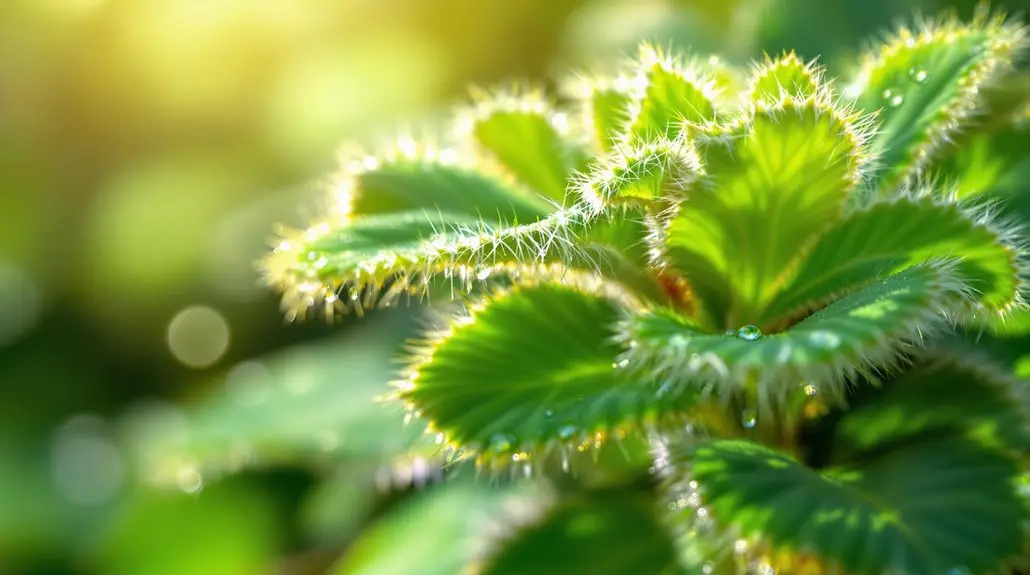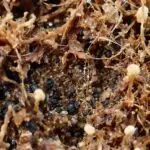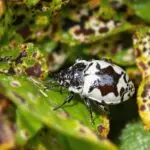Elaphandra quinquenervis features crucial essential oils rich in terpenoids that show effective pesticidal activity, especially against Aedes aegypti larvae. Key components like 1,8-cineole and viridiflorol contribute considerably to its insecticidal properties. The plant has an LC50 value of 61.1 µg/mL, demonstrating comparable efficacy to other natural pesticides. Its mechanisms include disrupting neurotransmitter function and energy production in insects, leading to mortality. This makes Elaphandra a promising option for eco-friendly pest management solutions. If you're curious about the plant's broader applications in agriculture and pest control, there's much more to explore.
Key Insights
- Elaphandra quinquenervis contains essential oils rich in terpenoids, including 1,8-cineole and viridiflorol, contributing to its pesticidal properties.
- The plant exhibits significant insecticidal activity against Aedes aegypti larvae, with an LC50 value of 61.1 µg/mL.
- Essential oils inhibit acetylcholinesterase, causing neurotransmitter buildup and leading to insect mortality.
- The combination of essential oils may enhance efficacy, aligning with Integrated Pest Management principles for sustainable practices.
- Research into Elaphandra quinquenervis offers eco-friendly alternatives to synthetic pesticides, promoting safer environments for non-target organisms.
Overview of Elaphandra Quinquenervis

Elaphandra quinquenervis is a striking perennial herb that catches the eye with its unique growth habit. You'll notice its basal rosette of hairy, grey-green leaves, which form a lush foundation for a single flowering stem that can reach up to an impressive meter tall. The plant boasts small, white, star-shaped flowers arranged in charming clusters, making it a delightful addition to any garden or park.
Native to Colombia, Elaphandra quinquenervis thrives in moist woods, thickets, and along streams, primarily found in tropical and subtropical regions. It's important to note that it's often misidentified in sources as being located in the southeastern United States or even the Himalayas, but that's not the case. This herb is truly a Colombian treasure, and its medicinal properties are known for treating skin diseases and infections. Additionally, the biodiversity of Colombia is enriched by such native species, highlighting the importance of conservation efforts.
When it comes to care, you'll find that Elaphandra prefers moist, well-drained soil and enjoys basking in full sun to partial shade. Regular watering will keep it healthy and vibrant.
If you're looking to propagate this beauty, you can do so by dividing the plant or sowing seeds in spring or early summer.
Beyond its aesthetic appeal, Elaphandra quinquenervis offers medicinal benefits, being used to treat various skin diseases and infections. Whether you're drawn to its beauty or its uses, this herb can certainly find a place in your life, inviting you to explore its rich qualities and connect with nature.
Essential Oil Composition
When exploring the essential oil composition of Elaphandra quinquenervis, you'll find a variety of key chemical components that play a role in its potential bioactivity. These include terpenoids like sesquiterpene and monoterpene hydrocarbons, which may contribute to its pesticidal properties. Understanding these bioactive molecules can shed light on how this plant might be harnessed for effective pest control. Additionally, the chemical composition of essential oils from related species, such as Melaleuca quinquenervia, often reveals a high concentration of terpenoids that enhance their medicinal and pesticidal applications. Notably, essential oils from American native plants like Elaphandra quinquenervis have demonstrated insecticidal activity against Aedes aegypti, indicating their potential in pest management. Furthermore, the natural pest control methods employed by companies like NaturePest highlight the increasing interest in plant-based solutions for pest management.
Key Chemical Components
While there's limited research on the essential oil composition of Elaphandra quinquenervis, it's likely to share similarities with other Asteraceae species known for their diverse chemical profiles. Typically, essential oils from this family boast a rich blend of terpenoids and phenolic compounds. You'll find that compounds like thymol, carvacrol, and γ-terpinene are common players in the essential oils of related plants, renowned for their pesticidal properties. Research shows that these compounds can exhibit significant larvicidal activity against pests like Aedes aegypti larvae and insecticidal effects against Anopheles gambiae. Their antifungal capabilities also add to their appeal, making them valuable in sustainable pest management. Moreover, studies have highlighted the antifungal resistance of certain pathogens, indicating the importance of discovering new natural pesticides. Additionally, the genus Elaphandra encompasses various species that may all contribute to similar chemical diversity and potential applications in pest control.
What's exciting is the potential synergy between these compounds, enhancing their effectiveness. Given the presence of similar components in Elaphandra quinquenervis, there's a promising opportunity for this plant to emerge as a natural pesticide. However, without thorough chemical analysis and testing of its essential oil, we can't fully understand its potential. So, embracing this journey of exploration could lead to discovering a powerful ally in pest control.
Bioactive Molecules Overview
The essential oil composition of Elaphandra quinquenervis likely harbors a wealth of bioactive molecules that can enhance its pesticidal properties. Among these, terpenes play a vital role. These hydrocarbons, including monoterpenes like limonene and sesquiterpenes such as myrcene, contribute to the oil's volatility and therapeutic effects. Their antioxidant and antimicrobial properties can greatly impact pest control. Furthermore, monoterpenes are known for their high levels of antibacterial, antiseptic, and anti-inflammatory effects.
In addition to terpenes, phenolic compounds act as radical trapping agents, inhibiting oxidative processes that can damage plant health. Aldehydes and ketones also add distinct aromas while offering therapeutic benefits.
When you consider extraction methods, like steam distillation, it's clear they affect the quality and efficacy of these bioactive molecules. Moreover, various essential oils demonstrate antimicrobial action against bacteria, fungi, and viruses, contributing to their therapeutic value.
The synergy found in the complex chemical profile of essential oils means they work better together, enhancing each other's effects. This means that Elaphandra quinquenervis could provide a multifaceted approach to pest management.
Key Insecticidal Compounds

When you explore the essential oil components of Elaphandra quinquenervis, you'll find they play a vital role in its insecticidal properties. Understanding the specific mechanisms behind their effectiveness can shed light on how these compounds target pests like Aedes aegypti. This knowledge not only highlights their potential for pest control but also emphasizes the need for further research into their applications. Additionally, the highest larvicidal activity observed in essential oils suggests promising avenues for the development of eco-friendly pest management solutions. Furthermore, these compounds align with the principles of Integrated Pest Management by promoting sustainable practices. Moreover, their effectiveness is enhanced when used in conjunction with alternative methods that prioritize sustainability and reduce chemical exposure.
Essential Oil Components
What makes the essential oil components of Melaleuca quinquenervia so effective as insecticidal agents? The secret lies in its rich composition. Key compounds like 1,8-cineole, viridiflorol, and α-pinene play significant roles. With 31.5% of the oil attributed to 1,8-cineole, it's no wonder this compound stands out as a major player in pest control.
Viridiflorol also shines, making up to 66% of twig oil. This variability across different plant parts highlights the adaptability of these oils in targeting pests. Additionally, EOs like TTO have been evaluated for their antimicrobial properties, demonstrating their effectiveness against a range of pests.
You'll notice that essential oils from the leaves are primarily terpenoids, while fruit and twig oils lean heavily toward sesquiterpenoids. This diverse chemical makeup allows for a range of insecticidal properties, including repellent and growth-inhibiting effects. Additionally, the effectiveness of these essential oils against specific insect pests emphasizes their potential in natural pest management strategies.
The potential synergy in combining these oils can enhance their overall pesticidal activity, making them viable options for natural pest management.
In a world increasingly leaning towards eco-friendly solutions, understanding the efficacy of these essential oil components in Melaleuca quinquenervia connects us to nature's own defenses, fostering a sense of belonging to a community that values sustainable practices.
Insecticidal Mechanisms Explained
Understanding the effectiveness of essential oil components in Melaleuca quinquenervia naturally leads to a closer look at the insecticidal mechanisms at play. Insects can resist pesticides through various strategies, and knowing these can help you appreciate the complexity of pest control.
One key mechanism is metabolic resistance. Resistant insects use internal enzyme systems to detoxify insecticides faster than their susceptible counterparts. They break down toxins and eliminate them quickly, making them harder to target. This challenge is particularly evident with the increasing resistance seen in Aedes aegypti mosquitoes against conventional insecticides. In fact, resistant strains often exhibit higher levels of enzyme activity that can break down multiple insecticides simultaneously.
Target-site resistance is another critical factor. Genetic modifications in insects can alter the sites where insecticides bind, rendering them ineffective. This means that even if you apply a pesticide, it mightn't work as intended.
Additionally, penetration resistance involves developing barriers that slow down toxin absorption, allowing insects to fend off chemicals more effectively.
Lastly, behavioral resistance shows how insects adapt by detecting dangers and avoiding treated areas altogether. They might stop feeding or move deeper into foliage to escape exposure.
Understanding these mechanisms is crucial for anyone interested in effective pest management strategies.
Insecticidal Activity Against Aedes Aegypti
Thymol, a natural compound derived from thyme, exhibits significant insecticidal activity against Aedes aegypti, making it a promising candidate for mosquito control. Its effectiveness is highlighted by its low LC50 value of 11.72 mg/L, indicating substantial toxicity. You'll be pleased to know that thymol can eliminate mosquito larvae within just 24 hours. When used at a concentration of 0.1 mg/mL, it results in a mortality rate of 26±1.1% among adult mosquitoes. Compared to other chemicals, thymol stands out for its rapid action and effectiveness. Recent studies have shown that the proliferation of Aedes mosquitoes has led to a significant increase in arboviral diseases, emphasizing the urgent need for effective control measures. Additionally, thymol's low movement potential in soil suggests that it may pose a reduced risk of contamination to groundwater compared to synthetic pesticides. Furthermore, effective mosquito control is crucial in regions such as South Florida where Aedes aegypti is prevalent.
Here's a quick overview of thymol's key insecticidal effects:
| Key Findings | Details |
|---|---|
| LC50 Value | 11.72 mg/L |
| Elimination Time | 24 hours |
| Mortality Rate | 26±1.1% at 0.1 mg/mL |
| Repellency | 99.5% landing inhibition |
| Necrosis in Hemocytes | Yes, without altering nitric oxide production |
Thymol not only impacts the larvae but also affects adult Aedes aegypti. Its necrotic effects on hemocytes disrupt metabolic processes, showcasing its potential as a broad-spectrum insecticide. This makes thymol an appealing choice if you're considering environmentally friendly alternatives to synthetic pesticides. By incorporating thymol into insecticide formulations, you could play a part in enhancing public health efforts against mosquito-borne diseases.
Understanding LC50 Values

When it comes to pest control, understanding LC50 values is essential. These values represent the concentration of a pesticide needed to kill 50% of test organisms, giving you insight into its effectiveness and security. Recent research has shown that essential oils, such as those from Elaphandra quinquenervis, exhibit promising insecticidal activity against Aedes aegypti larvae, making them a valuable consideration in pest management strategies. Additionally, using low-impact products can help minimize harm to beneficial insects while effectively managing pest populations.
Definition of LC50 Value
The LC50 value, a significant metric in toxicology, represents the concentration of a substance that's lethal to 50% of a test population, often measured over specific exposure periods. This value is critical for understanding how potent a substance can be, especially in pest control contexts.
You'll typically see it expressed in parts per million (ppm) or parts per billion (ppb), making it easier to compare different substances. LC50 values are determined through testing various exposure times, like 24, 48, or even 96 hours. Generally, longer exposure results in lower LC50 values, indicating higher toxicity.
It's fascinating how this metric can vary depending on the method of exposure—whether through inhalation, contact with pesticide dust, or spray mist. Additionally, the variability in toxicity results can significantly influence LC50 values, as factors like water quality and temperature can alter toxicity outcomes.
When you look at LC50 values, remember that lower numbers signal higher toxicity. This becomes imperative for understanding pesticide labels, as these values guide the signal words you'll find, like "Danger" or "Caution."
Ultimately, LC50 values play an essential role in evaluating the security and environmental impact of substances we encounter, helping all of us make informed decisions.
Significance in Pest Control
Understanding LC50 values is essential for effective pest control, as they provide a clear measure of a pesticide's toxicity. By grasping these values, you can make informed decisions about how to manage pests while protecting the environment and non-target organisms.
Here are four key reasons why LC50 values matter in pest control:
- Toxicity Comparison: LC50 values allow you to compare the lethal effects of different pesticides, helping you choose the most effective option for your situation.
- Guiding Application Rates: These values inform the ideal dosages needed to achieve pest control without overusing chemicals, which can lead to environmental harm. For example, products like Acelepryn provide season-long control with a single application, reducing the need for multiple treatments. Additionally, knowing the 24-hr LC50 values for specific pesticides helps in understanding their acute toxicity.
- Monitoring Resistance: By tracking LC50 values over time, you can assess changes in pest susceptibility, helping you adapt your pest management strategies.
- Risk Assessment: LC50 values help evaluate the potential risks pesticides pose to both human health and the environment, ensuring more secure pest control practices.
Embracing the significance of LC50 values empowers you to contribute to sustainable pest management, fostering a healthier ecosystem for everyone.
Comparison With Other Compounds
Comparing the LC50 values of Elaphandra quinquenervis with those of other compounds highlights its effectiveness as a pesticide against Aedes aegypti larvae. With an LC50 value of 61.1 µg/mL, Elaphandra quinquenervis is on par with Hyptis dilatata, which shares the same toxicity level.
However, when you look at Steiractinia aspera, with a lower LC50 of 42.4 µg/mL, it shows higher toxicity. Piper aduncum, though slightly less effective at 55.8 µg/mL, still performs competitively.
The Lippia origanoides, characterized by different chemotypes, shows a range in effectiveness, with values of 61.9 µg/mL and 59.8 µg/mL, indicating moderate toxicity.
These comparisons reveal that while Elaphandra quinquenervis holds its ground, other compounds may offer advantages in specific scenarios. Additionally, the highest larvicidal activity was observed in Steiractinia aspera, underscoring the importance of exploring multiple EOs for effective pest management.
Understanding these LC50 values is essential for making informed decisions in pest control. A lower LC50 means higher toxicity, allowing for more effective pest management. Furthermore, the mortality rates achieved by various insecticides in studies emphasize the significance of assessing different pest control methods.
For anyone passionate about effective pest solutions, this comparison can guide you in choosing the right pesticide for your needs.
Mechanism of Action
Insecticides derived from Elaphandra quinquenervis exhibit a complex mechanism of action that disrupts essential physiological processes in target pests.
You'll find that these compounds target several critical systems within insects, leading to their demise. Here are some key ways they work:
- Acetylcholinesterase Inhibition: This action causes a buildup of neurotransmitters, resulting in heightened nervous excitement and eventual death.
- GABA Receptor Interaction: The active substances bind to GABA receptors, leading to severe disruptions in neuronal activity.
- Electron Transport Chain Disruption: By affecting mitochondrial protein complexes, these compounds hinder energy production, which is crucial for insect survival.
- Octopamine/Tyramine Receptor Inhibition: This interference greatly impacts the insect's nervous system, further contributing to their downfall.
These mechanisms culminate in severe biochemical effects, including neuronal hyperexcitation and mitochondrial dysfunction. Additionally, the effectiveness of these insecticides can be enhanced by the inclusion of fast-acting and long-lasting residual control, which provides growers with more reliable pest management solutions. You can think of it as throwing the insect's internal systems into chaos. The resulting oxidative stress and impaired detoxification processes make the pests far more vulnerable to environmental challenges. Furthermore, the potential for natural compounds like those from American native plants to serve as effective insecticides highlights the importance of exploring diverse sources for pest management solutions.
Mitochondrial Disruption Explained

Mitochondrial disruption plays a significant role in the effects of insecticides derived from Elaphandra quinquenervis. When you think about how these insecticides work, it's essential to understand that mitochondrial dysfunction can arise from various factors.
Genetic mutations in mitochondrial DNA can lead to serious issues, while environmental exposures—like pollution and certain chemicals—further contribute to this damage. Chronic inflammation can exacerbate these mitochondrial dysfunctions, leading to increased oxidative stress and further impairing muscle function.
Oxidative stress from high levels of reactive oxygen species (ROS) can impair mitochondrial function, causing an imbalance in the delicate processes of fission and fusion that maintain mitochondrial health. Additionally, it's crucial to note that 1 in 4,300 individuals are affected by mitochondrial disease, highlighting its prevalence and impact on health.
You might also find it interesting that lysosomal dysfunction, which affects the removal of damaged mitochondria, plays a part in this disruption.
The symptoms of mitochondrial disruption can be quite severe. You or someone you know might experience muscle weakness, neurological issues, and even developmental delays.
Metabolic issues such as diabetes or kidney problems, alongside cardiovascular complications, can also stem from mitochondrial dysfunction.
Understanding these mechanisms is vital, as they highlight the importance of mitochondrial health for overall cellular function.
By addressing lifestyle factors and considering antioxidant therapies, you can take proactive steps to support mitochondrial health.
This journey of understanding and healing can foster a sense of belonging within a community that values health and wellness, reminding us that we're not alone in tackling these challenges.
AChE Inhibition Mechanism
AChE inhibition is an essential mechanism in pest control, targeting the enzyme acetylcholinesterase to disrupt neurotransmission in insects. When you understand how this mechanism works, you'll realize why it's a validated target for developing effective pesticides. Here are a few key points to take into account:
- Acetylcholinesterase (AChE) hydrolyzes acetylcholine, terminating nerve impulses.
- Inhibiting AChE is lethal to insects, making it a powerful pest control strategy.
- AChE inhibitors can bind to the enzyme's active site, either reversibly or irreversibly.
- Natural products, like plant secondary metabolites, hold promise as AChE inhibitors.
The mechanism of AChE inhibition involves various pathways. Organophosphates and carbamates, for example, covalently bind to a serine residue in the active site, effectively blocking the enzyme's function. Recent studies have also shown that pesticide toxicity can be predicted using a developed in silico prediction framework for analyzing compounds.
On the other hand, some natural compounds, such as sesquiterpenoids from *Laggera pterodonta*, inhibit AChE in a reversible manner. Recent findings indicate that eudesmane-type sesquiterpenes derived from *Laggera pterodonta* exhibit significant AChE inhibitory activity, underscoring the potential of natural compounds in pest management.
Kinetic analysis of these inhibitors helps determine their binding affinity and inhibition type. Molecular docking studies also play an important role, identifying binding sites on AChE, which can inform the design of more effective inhibitors.
As you explore the world of AChE inhibition, you'll find that understanding the structure-activity relationship of these compounds is essential for enhancing their efficacy and specificity in pest control.
Together, we can appreciate the potential of natural products in creating more secure alternatives to synthetic pesticides.
Comparative Analysis With Other Plants

Understanding the pesticidal properties of various plants is essential for developing effective pest control strategies. When you look at Elaphandra quinquenervis, its LC50 value of 61.1 µg/mL against Aedes aegypti larvae puts it in a competitive position among other plants. However, some plants show even stronger efficacy, making it vital to compare these values.
Here's a quick comparison to illustrate the differences:
| Plant | LC50 Value (µg/mL) |
|---|---|
| Steiractinia aspera | 42.4 |
| Piper aduncum | 55.8 |
| Elaphandra quinquenervis | 61.1 |
| Hyptis dilatata | 61.1 |
| Lippia origanoides | 61.9 |
As you can see, while Elaphandra's efficacy is commendable, it isn't the highest among its peers. Its essential oils are known to disrupt the electron transport chain, specifically targeting mosquito larvae. Other plants like Steiractinia aspera and Piper aduncum show greater potency, which could make them preferable options in certain pest control scenarios. Additionally, the potential for Elaphandra quinquenervis to tackle non-mosquito pests remains an area worth exploring. By understanding these comparative dynamics, you can make informed decisions about which natural pesticides might best suit your pest management needs and contribute to a more sustainable approach to agriculture. Furthermore, understanding that systemic insecticides can pose risks to pollinators highlights the importance of evaluating natural alternatives like Elaphandra quinquenervis in integrated pest management strategies. This evaluation becomes crucial as many products are selected based on their impact on beneficial insects, particularly bees.
Natural vs. Synthetic Insecticides
When choosing between natural and synthetic insecticides, it's essential to weigh their benefits and drawbacks. Each option has unique characteristics that can impact your gardening or farming experience. Here's a quick comparison:
- Persistence: Natural insecticides break down quickly, requiring more frequent applications, while synthetic options offer longer-lasting protection.
- Selectivity: Natural insecticides often target specific pests, reducing harm to beneficial insects. In contrast, synthetic ones can affect a broader range of species, including pollinators.
- Cost: Synthetic insecticides tend to be less expensive and more readily available, whereas natural alternatives can be pricier and harder to find.
- Speed of Action: You may notice faster results with synthetic insecticides, while natural options could take longer to show effectiveness. Additionally, it is important to note that toxicity levels can vary between organic and synthetic options, making careful label reading essential. Choosing natural insecticides can lead to healthier ecosystems and promote the survival of beneficial organisms in your garden. They're generally more secure for children and pets, too. Furthermore, they reduce carbon footprint, promoting environmental sustainability.
However, you'll need to stay vigilant, as they require more frequent applications and may not control all pest species effectively.
On the other hand, if you prioritize immediate results and broad-spectrum control, synthetic insecticides might appeal to you. Just be mindful of their potential impact on the environment and beneficial insect populations.
Ultimately, the best choice depends on your specific needs and values as a gardener or farmer. Balancing these factors can help you create a thriving, sustainable growing environment.
Environmental Impact Considerations
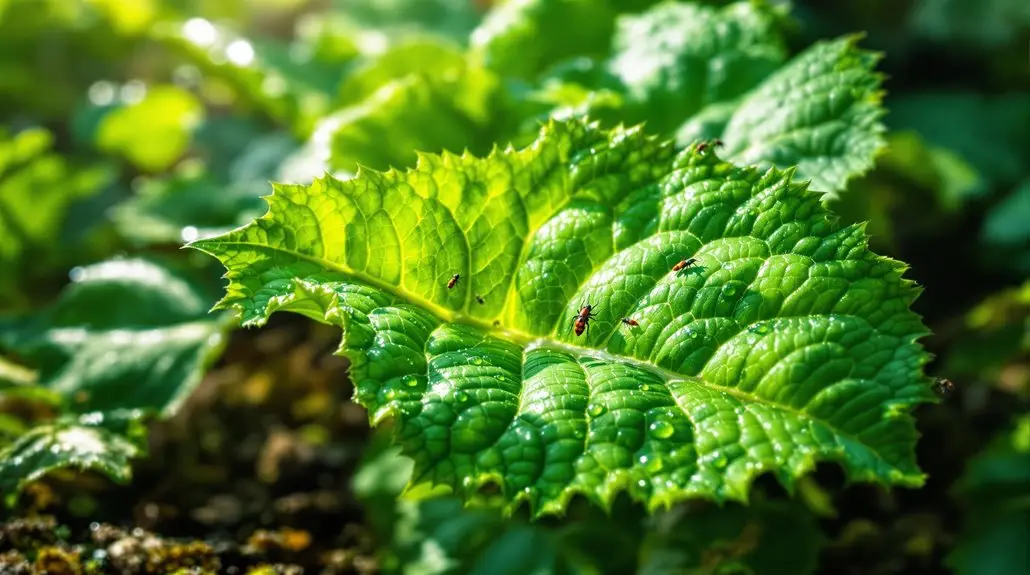
The environmental impact of pesticides, including those derived from plants like *Elaphandra quinquenervis*, raises significant concerns that every gardener or farmer should consider.
While essential oils from this plant show promise as a larvicide against *Aedes aegypti* larvae, it's vital to think about the broader ecological effects. These oils can disrupt mitochondrial functions, which may have unintended consequences for non-target organisms in your garden or farm. Furthermore, research has indicated that certain essential oils, such as those from *E. quinquenervis*, may be effective in targeting AChE activity, which highlights their potential for selective pest control. Choosing services from experts in natural pest control can help mitigate these risks effectively.
Pesticides can lead to habitat destruction and pollution, harming both soil and water systems. For example, soil fumigants can pose health risks to you and your family, not to mention the potential contamination of local waters that affects aquatic life. Additionally, mining operations monitored for chemical emissions can result in global pollution that jeopardizes local ecosystems.
Additionally, the mining industry connected to extracting pesticide ingredients can cause long-lasting environmental damage, taking centuries to recover from.
In light of these impacts, many regions are tightening regulations on harmful pesticides, like neonicotinoids, to protect both human health and the environment. New York State is leading the charge by prohibiting these substances in outdoor ornamental plants starting in 2024.
As you consider your pest control options, exploring natural and eco-friendly pesticides is a responsible step.
Research into the compounds in plants like *E. quinquenervis* offers hope for developing less hazardous alternatives. By opting for integrated pest management and innovative practices, you can contribute to a healthier ecosystem while still protecting your plants.
Together, we can make choices that benefit our environment and promote sustainable gardening.
Applications in Mosquito Control
When it comes to mosquito control, targeting Aedes aegypti larvae is vital. Elaphandra quinquenervis offers a promising eco-friendly alternative. Its essential oil shows effective larvicidal activity, presenting a potential option for sustainable pest management. Additionally, incorporating surveillance techniques can enhance the effectiveness of this natural solution in identifying hotspots for larvicidal application. Integrated Pest Management (IPM) also emphasizes the importance of community involvement in monitoring and managing mosquito habitats, which can further support the use of this natural solution in existing strategies for controlling mosquito populations.
Targeting Aedes Aegypti Larvae
Targeting Aedes aegypti larvae is fundamental for effective mosquito control, especially given their role in transmitting diseases like dengue and chikungunya. Furthermore, the presence of Aedes mosquitoes in urban areas and their preference for standing water highlights the necessity for targeted larvicidal applications in such environments.
To make a real impact, consider these key larvicides that have shown 100% efficacy against these bothersome larvae:
- Bti (Bacillus thuringiensis var. israelensis): A natural bacterium that kills larvae without harming other wildlife.
- Pyriproxyfen: A growth regulator that disrupts the development of Aedes aegypti.
- Temephos: A chemical larvicide that's proven to be highly effective.
- Larvicidal Oil: Targets all immature stages, achieving impressive mortality rates.
Incorporating these larvicides into thorough control programs can greatly interrupt the dengue transmission cycle. Additionally, the resistance to temephos observed in Aedes aegypti populations necessitates the use of alternative insecticides to maintain effective control.
Rotating these agents can also be a smart strategy to prevent resistance in mosquito populations.
Remember, understanding the ecology and behavior of Aedes aegypti, including their host feeding patterns, is essential for creating a cohesive control plan.
By taking these steps, you can play an important role in protecting your community and reducing the threat of vector-borne diseases.
Together, we can make a difference!
Eco-Friendly Insecticide Alternative
Exploring eco-friendly insecticide alternatives is essential for effective mosquito control while protecting the environment.
You can embrace biological control methods like Bacillus thuringiensis israelensis (Bti), which targets mosquito larvae without harming other beneficial organisms. Consider inviting dragonflies and damselflies into your garden; these natural predators help keep adult mosquito populations in check.
Incorporating mosquito-repellent plants such as citronella, lavender, and marigold not only beautifies your space but also creates a natural barrier against these pests.
You can use botanical extracts from rosemary or lemongrass as effective repellents, either in homemade sprays or as essential oils mixed with carrier oils.
Participating in integrated mosquito management is vital. It combines larval control and source reduction with environmentally friendly larvicides endorsed by the CDC and EPA.
Remember, community involvement amplifies the impact of these strategies. By modifying your garden and using plant-based repellents, you contribute to a collective effort in preserving our ecological balance while effectively managing mosquito populations.
Together, we can foster a healthier environment for ourselves and future generations.
Agricultural Implications

As the agricultural sector increasingly seeks sustainable solutions, the pesticidal composition of Elaphandra quinquenervis presents promising implications for pest management. This plant's essential oils (EOs) show significant efficacy against pests like Aedes aegypti, demonstrating not only high larvicidal activity but also potential as a biopesticide.
Here are some key agricultural implications to evaluate:
- Effective Pest Control: The EOs' ability to inhibit acetylcholinesterase activity by 33% underscores their effectiveness, offering a natural alternative to traditional pesticides.
- Healthier for the Environment: Utilizing these EOs can minimize the environmental and health risks associated with chemical pesticides, supporting healthier ecosystems.
- Market Opportunities: The increasing consumer demand for biopesticides, driven by safety concerns and regulatory pressures, opens new avenues for farmers and businesses alike.
- Innovation in Biopesticides: With advancements in technologies like RNA interference and sterile pollen, the development of innovative biopesticides from EOs can enhance pest management strategies.
Integrated Pest Management Strategies
How can farmers effectively manage pest populations while minimizing environmental impact? One powerful approach is Integrated Pest Management (IPM). This method combines preventative and cultural techniques with biological, physical, and chemical controls, tailoring strategies to fit your unique farm needs.
By understanding pest ecology and the effects of pesticides on non-target organisms, you can create a holistic plan that addresses the entire pest complex affecting your crops.
Implementing IPM isn't without its challenges. Many farmers struggle with the complexity of integrating these diverse strategies. A lack of awareness about IPM principles can hinder adoption, but you're not alone. Engaging in educational programs can bridge this knowledge gap, empowering you with effective practices that promote sustainability.
Moreover, IPM isn't just about controlling pests; it's about building resilience. The approach encourages ongoing monitoring and adjustment, allowing you to adapt to changing pest pressures and environmental conditions.
With proven long-term advantages, like reduced costs and less reliance on chemical pesticides, adopting IPM can lead to healthier ecosystems and increased biodiversity.
You're part of a community of farmers who are increasingly recognizing the value of IPM. By collaborating and sharing information, we can enhance regional coordination and support each other in embracing these eco-friendly practices.
In doing so, not only do you protect your crops, but you also contribute to a more sustainable agricultural future for everyone.
Future Research Directions
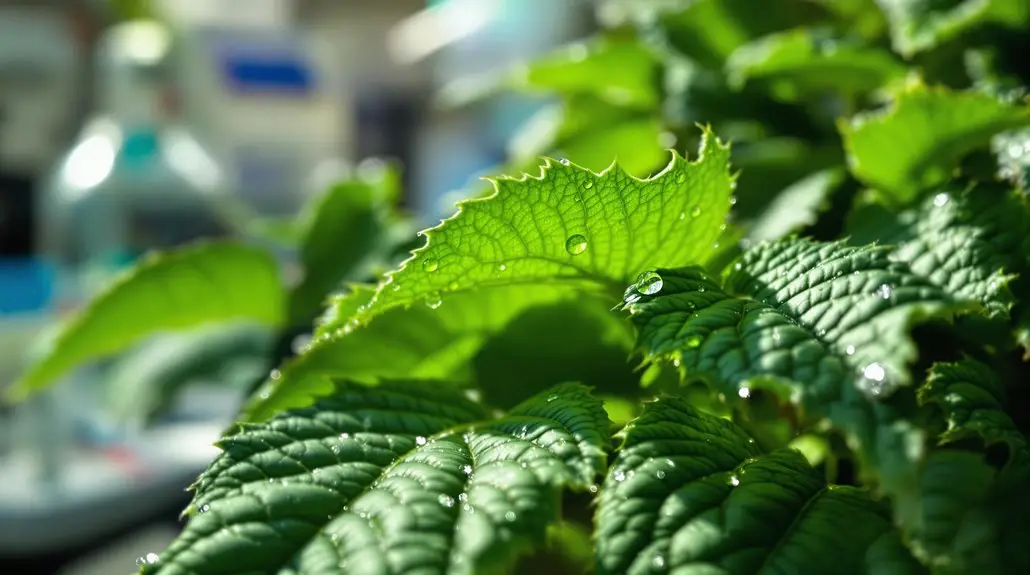
Future research directions for the pesticidal composition of Elaphandra quinquenervis focus on enhancing our understanding of its mechanisms and improving its application in pest management.
By diving deeper into its properties, you can contribute to creating more secure and more effective pest control solutions. Here are some key areas to emphasize:
- Investigating Mechanisms of Action: Study the biochemical pathways influenced by Elaphandra quinquenervis oils, particularly their effects on the mitochondrial electron transport chain and acetylcholinesterase activity in pests.
- Enhancing Efficacy and Safety: Develop formulations that boost the pesticidal activity of Elaphandra quinquenervis while reducing environmental risks. This can include exploring synergistic effects when combined with other natural compounds.
- Ecological Considerations: Conduct ecological risk assessments to evaluate the effects of these essential oils on non-target organisms and biodiversity. Understanding their impact on sensitive ecosystems is vital.
- Regulatory Guidelines: Establish guidelines for the secure use of Elaphandra quinquenervis as a pesticide, ensuring it poses minimal risks to human health and the environment.
Frequently Asked Questions
Is Elaphandra Quinquenervis Safe for Human Health?
You might be wondering if Elaphandra quinquenervis is secure for human health. While it shows promise as a natural pesticide, its toxicity to humans hasn't been extensively studied.
The risks associated with pesticide exposure are real, especially for agricultural workers. It's essential to be cautious and stay informed about potential health hazards.
Always consider safety guidelines and seek alternatives when possible, ensuring you prioritize your health and the well-being of those around you.
How Can I Extract Essential Oils From This Plant?
Have you ever wondered how to capture the essence of a plant? You can extract essential oils from Elaphandra quinquenervis using methods like steam distillation, solvent extraction, or CO2 extraction.
Each method has its perks—steam distillation is popular, while CO2 extraction preserves purity. For delicate flowers, enfleurage works wonders.
Choose the method that fits your needs, and enjoy the aromatic experience of creating your own essential oils from this unique plant!
What Are the Best Application Methods for These Oils?
When applying essential oils, you'll find that spraying or vaporizing works best for even distribution over targeted areas.
Timing's key too; applying oils early in pest cycles often boosts effectiveness.
Remember to dilute the oils to prevent plant toxicity, and store them in a dark, cool place to maintain potency.
Don't forget your protective gear and guarantee good ventilation during application to keep everyone secure and feeling comfortable.
Are There Any Known Side Effects of Using This Oil?
When using essential oils, it's important to be aware of potential side effects. You might experience skin irritation or allergic reactions, especially if you have sensitive skin.
While specific data on Elaphandra quinquenervis is limited, oils in general can cause discomfort when applied improperly.
Always do a patch test and consult with a healthcare professional if you're unsure. Being cautious guarantees you enjoy the benefits without unwanted reactions.
Can Elaphandra Quinquenervis EOS Be Combined With Other Insecticides?
You might worry that combining different insecticides could lead to ineffective results or harmful interactions, but that's not necessarily the case.
Elaphandra quinquenervis essential oil shows promise when paired with synthetic insecticides. This combination could enhance pest control while minimizing the amount needed, which is great for the environment.
Collaborating with others in this research can lead to innovative solutions that benefit everyone. Together, you can explore exciting possibilities in pest management!
Conclusion
In the grand garden of pest control, Elaphandra quinquenervis stands as a vigilant gardener, wielding its essential oils like a trusty watering can. With its potent insecticidal compounds, it nurtures a healthier ecosystem by targeting troublesome Aedes aegypti. As you gather insights from this natural ally, envision a harmonious balance between agriculture and nature.
At NaturePest Holistic Pest Control, we invite you to embrace these eco-friendly solutions and join us in paving the way for a flourishing future. By integrating the power of Elaphandra quinquenervis into your pest management practices, you can help ensure that every plant thrives and every pest learns to respect the delicate dance of life. Together, let's cultivate a healthier environment for generations to come!

